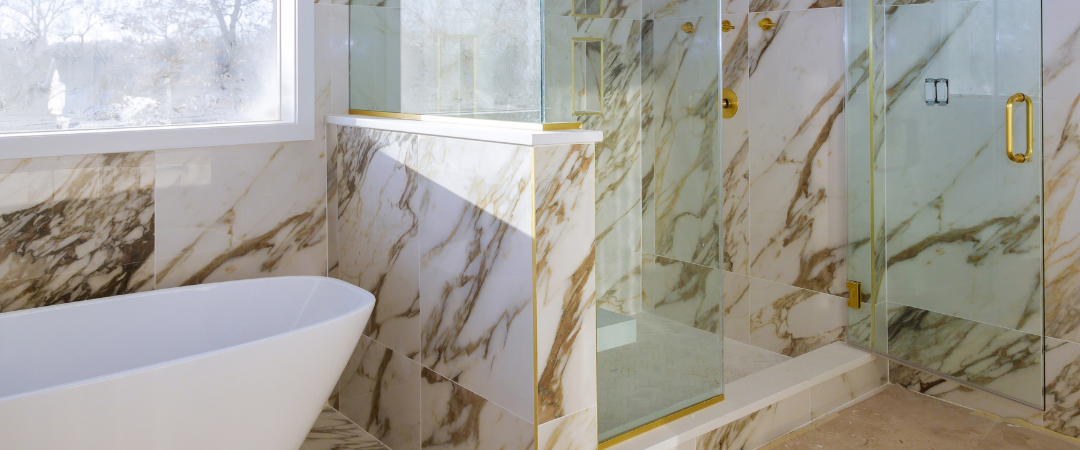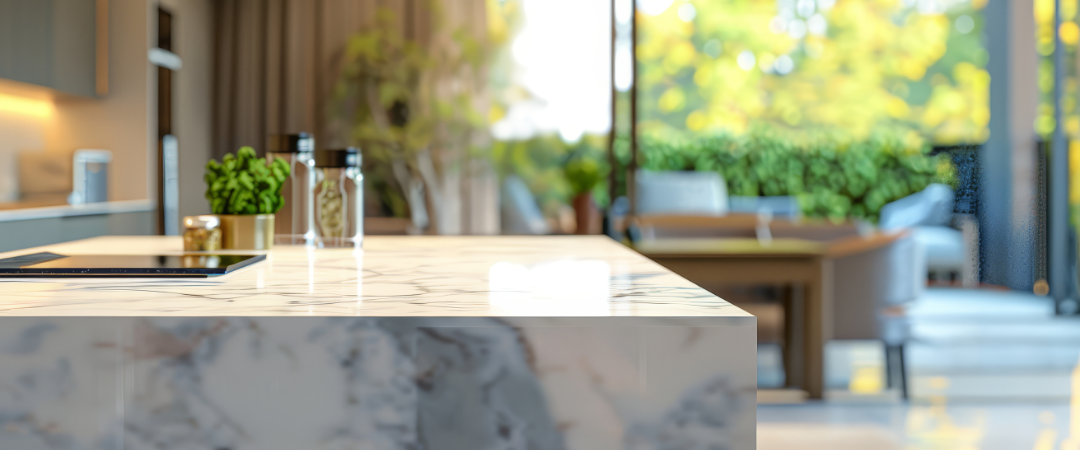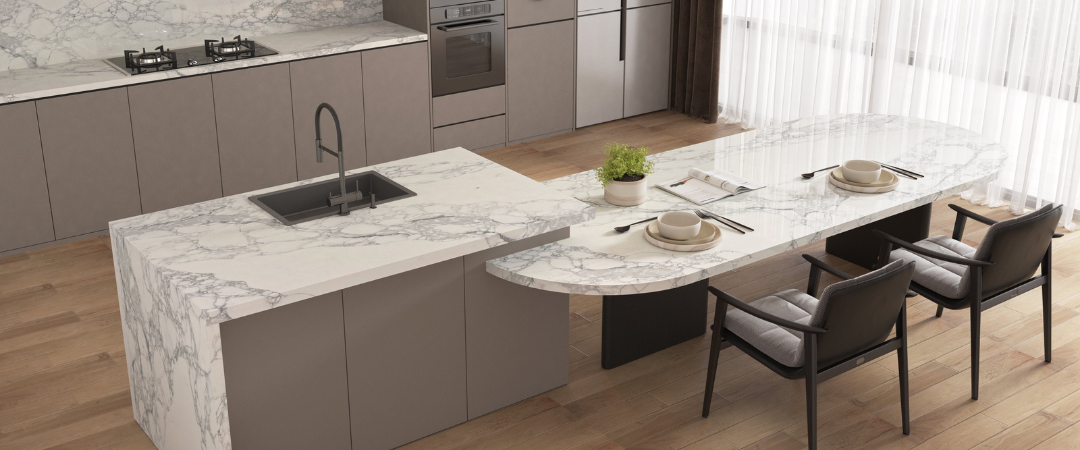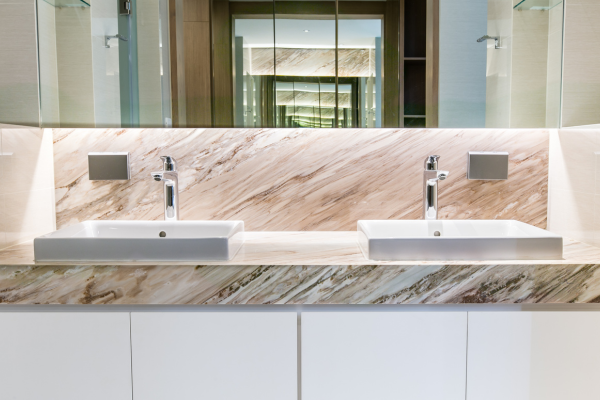Why Marble Still Captivates Homeowners
The Timeless Allure of Natural Stone
Marble has that “little black dress” energy—effortless, refined, and always appropriate. Unlike busy synthetics, marble reads as quietly luxurious. Each slab carries a one-of-a-kind pattern, like nature’s own fingerprint, which instantly elevates kitchens, bathrooms, laundry rooms, and even fireplace surrounds.
Beauty That Evolves With Patina
If you love things that age gracefully—leather boots, heirloom copper, solid-wood tables—marble belongs in your home. Over time, it develops a soft patina. Yes, it can etch and stain if neglected, but with basic care you’ll get that lived-in, European café character that never feels trendy or tired.
Popular Marble Varieties (and What Makes Each Unique)
Carrara vs. Calacatta vs. Statuario
- Carrara: Typically softer gray background with feathery, linear veining. Versatile, classic, and often more budget-friendly.
- Calacatta: Bolder, larger veins that can range from charcoal to warm golds on a whiter background. Statement-making and rarer.
- Statuario: A dramatic, bright white field with striking, well-defined veins—often considered museum-worthy when bookmatched.
Nero Marquina, Arabescato, and Beyond
- Nero Marquina: Inky black base with sharp white veins—stellar for moody kitchens or powder rooms.
- Arabescato: Soft white with swirling, rope-like veining—great for bookmatched walls that feel like art.
- Danby, Vermont: Warmer whites with subtle grays; beloved for New England charm and performance.
Veining Patterns and Color Tones
Veining can be linear, cloud-like, or dramatically bold. Cooler marbles lean bluish-gray; warmer marbles show honey, taupe, or even golden accents. Choose veining and undertone first—they dictate everything else from cabinet colors to hardware finishes.

Design Directions You’ll Love For Marble Countertops
Modern Minimalist Kitchens
Pair a quiet, honed Carrara with matte black or pale oak cabinetry. Keep lines clean—think slab doors, hidden appliances, and an ultra-slim mitered edge for that tailored look.
Classic European-Inspired Spaces
Calacatta with brass hardware and creamy cabinets gives you that Paris-meets-Rome feel. Add a traditional ogee edge, bridge faucet, and ceiling-height slab backsplash for old-world charm.
Spa-Like Marble Bathrooms
Use marble on vanities, shower walls, and threshold details. A leathered finish on floors provides grip and reduces glare, while a polished vanity top bounces light for a fresh, spa vibe.
Waterfall Islands, Full-Height Slabs, and Bookmatching
- Waterfall Islands: Marble flows to the floor like a runway—minimal seams, maximum drama.
- Full-Height Slab Backsplashes: No grout lines; just pure stone artistry behind your range or sink.
- Bookmatching: Two adjacent slabs mirror each other for a butterfly effect. It’s showstopping behind freestanding tubs or on feature walls.
Finish Options: Honed, Polished, or Leathered Marbel Countertops
How Each Finish Changes the Look
- Polished: Glossy and reflective; colors appear deeper and more saturated. Great for glamorous kitchens but shows etches more readily.
- Honed: Matte, velvety look that disguises small scratches and softens bright veining. A design darling for modern and classic spaces alike.
- Leathered/Brushed: Subtle texture you can feel; reduces glare, adds grip, and brings organic warmth.
Slip, Glare, and Etching Considerations
Floors benefit from honed or leathered finishes for traction. Countertops that see citrus and wine will etch less noticeably with honed finishes. Lighting matters too—polished can sparkle under pendants; honed keeps things calm in daylight.

Edge Profiles and Thickness
Eased, Beveled, Ogee, and Mitered Edges
- Eased: Minimal rounding—clean and modern.
- Beveled: A small angled cut that catches light—great with classic kitchens.
- Ogee: S-shaped curve for a traditional, furniture-like profile.
- Mitered: Two pieces joined at 45° to create the illusion of a thick slab—perfect for islands and waterfalls.
2 cm vs. 3 cm (and When to Build Up)
- 2 cm: Lighter and often more cost-effective; ideal when you’ll miter the front for a thick look.
- 3 cm: Naturally substantial; fewer build-ups needed and excellent for heavy use.
Pairing Marble Countertops With Cabinets, Floors, and Backsplashes
Warm vs. Cool Palettes
- Cool Marble (blue-gray veining): Pairs with crisp whites, black, graphite, and cool metals like stainless or chrome.
- Warm Marble (golden/taupe veining): Loves creamy paints, natural oaks, unlacquered brass, and warm limestone floors.
Metals, Woods, and Tile Pairings That Pop
- Metals: Brass warms Carrara; polished nickel flatters Calacatta; matte black frames Nero Marquina flawlessly.
- Woods: Rift-sawn white oak is universally flattering; walnut adds richness.
- Tile: Handmade zellige adds texture; large-format porcelain keeps focus on the marble.
Practical Performance: Heat, Stains, and Etching
Sealing and Everyday Habits That Matter
A good impregnating sealer reduces staining, and re-sealing on schedule keeps performance consistent. Wipe spills quickly (especially wine, coffee, citrus). Use cutting boards. Coasters are tiny superheroes.
Realistic Expectations = Long-Term Happiness
Marble may etch where acids touch it. That’s normal, and many homeowners embrace it as part of marble’s lived-in charm. If you want zero patina, consider placing marble where it’s less exposed (island, baking zone, bathroom vanity) and pick a honed finish.
Marble Varieties at a Glance
|
Marble Type |
Base Color | Veining Style | Best For | Style Vibe |
|
Carrara |
Soft gray-white | Fine, linear | Everyday kitchens & baths |
Classic, understated |
|
Calacatta |
Bright white | Large, bold, sometimes gold | Feature islands, backsplashes |
Luxe, high-impact |
| Statuario | Brilliant white | Dramatic, defined | Bookmatched walls, statement tops |
Gallery-level elegance |
|
Arabescato |
White | Swirling, rope-like | Full-height slabs, showers |
Artistic, fluid |
|
Nero Marquina |
Deep black | Sharp white veining | Powder rooms, bars | Modern, moody |
|
Danby (Vermont) |
Warm white | Soft gray | Traditional kitchens |
Cozy, New England |
Care & Maintenance Schedule
Care & Maintenance Schedule (At-a-Glance)
|
Task |
Frequency | Why It Matters |
Quick How-To |
|
Seal countertops |
Every 6–12 months | Reduces staining from oils and wine |
Use an impregnating sealer; apply, dwell, wipe, buff |
|
Daily wipe-down |
Daily | Prevents buildup and etch marks | pH-neutral stone cleaner; soft cloth or paper towel |
|
Blot spills |
Immediately | Stops acids from etching | Blot (don’t rub) citrus, vinegar, wine; rinse & dry |
|
Deep clean |
Weekly | Removes film and enhances luster |
Stone-safe concentrate; microfiber cloth |
|
Stain treatment |
As needed | Lifts oil/organic stains |
Poultice per manufacturer; re-seal afterward |
| Etch refresh |
As needed |
Softens appearance of etches |
Use marble polishing compound (honed shows less) |
Installation Essentials for Marble Countertops
Templating, Seam Placement, and Support
Pros will create precise templates to guide fabrication. For long runs, seams are inevitable—ask to place them away from focal points and align veins across joints. Overhangs and cutouts (sinks, cooktops) may require brackets or steel bars for proper support, especially on mitered waterfalls.
Sinks, Backsplashes, and Cutouts
- Undermount Sinks: Sleek, hygienic, and visually light. Request a slight top reveal or flush reveal based on cleaning preference.
- Full-Height Backsplashes: Fewer joints, easier wipe-downs, and a cohesive canvas for the stone’s story.
- Cutouts: Discuss faucet holes, soap dispensers, and pop-up outlets during templating to avoid surprises.

Cost Factors and How to Budget a Marble Countertop
Slab Grade, Rarity, and Fabrication Complexity
Marble pricing varies with quarry, block quality, slab thickness, and rarity. Complex edges, mitered waterfalls, and bookmatching increase fabrication time and skill—budget accordingly. Remember: installation quality influences both durability and beauty.
Smart Ways to Save Without Compromising Style
- Choose Carrara or Danby for classic looks at approachable prices.
- Use marble where it shows (island, vanity) and pair with a budget-friendly surface on secondary runs.
- Opt for a honed finish to gracefully disguise minor wear in high-traffic homes.
Sustainability and Ethical Sourcing
Ask your fabricator about quarry practices, transport footprint, and recycling of remnant pieces (think: shelves, pastry boards, thresholds). Natural stone is durable and repairable—two green checkmarks.
Is Marble Right for You? A Quick Self-Assessment
- Do you appreciate materials that develop character over time?
- Are you open to routine care (quick wipe-downs, periodic sealing)?
- Do you want a surface that feels cool to the touch (bakers, rejoice!) and looks upscale without shouting?
If you’re nodding “yes,” marble is likely your match.
Conclusion
Marble countertops are the definition of enduring elegance. From Carrara’s quiet charm to Calacatta’s dramatic veining, there’s a look for every design style. With the right finish, thoughtful installation, and simple care habits, marble doesn’t just stay beautiful—it becomes more yours as it ages. Whether you go for a waterfall island, a slab backsplash, or a serene bathroom vanity, marble brings that timeless, artisan quality you simply can’t fake.
Marble Countertops FAQs
‣ Will sealing prevent all stains and etching?
Sealing helps resist stains, not etching. Etching is a reaction to acids. Blot spills quickly and consider a honed finish to make etches less visible.
‣ Is marble too soft for kitchens with kids?
Not at all—just set expectations. Use cutting boards, coasters, and a pH-neutral cleaner. Many families love the patina that develops with real life.
‣ Which marble is best for a bright, airy kitchen?
Look for Calacatta or Statuario if you want bold contrast against white cabinets, or Carrara for a softer, classic vibe.
‣ How often do I need to re-seal?
Typically every 6–12 months, depending on use and product. A quick water droplet test (if it darkens the stone fast, it’s time) is your best guide.
‣ Can I use marble outdoors?
Only in covered or mild environments. UV, rain, and freeze-thaw cycles are harsh on marble. Discuss your climate and exposure with a stone pro before installing outside.

